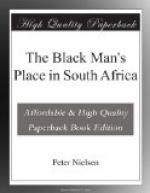Joy and sorrow, love and hatred, hope and fear, these are the fundamental emotions of human kind. Can any difference be detected between these feelings in the two races?
No one who knows him will say that the Native’s capacity for the “joy of life unquestioned” is less than that of the average white man. Most Natives are born lovers of song and music, and attain easily to technical proficiency in the art of harmony. The aesthetic sense is present in the average Native as it is in the average European and in both is easily overlooked when not stimulated and developed by education and culture. That the Natives, as a whole, feel the sorrows of life and death as keenly as do the people of other races will be readily admitted by all who know them well, although their way of showing their sorrow may differ from those prescribed by the canons of conduct of other communities. It is assumed by many that love, “the grand passion,” has been brought to a finer point, as it were, among the white people than anywhere else, and it may well be that monogamy is conducive to the growth of a higher and purer form of sexual reciprocity than is possible under the polygamous system of the Natives and other peoples. The monogamous marriage, though based on sexual attraction in the first instance, tends to become, as the man and the woman grow older, a union of souls, so to speak, more or less independent of the sexual element itself. The close and continued association of one man and one woman of compatible temperaments no doubt brings about a state of mutual intimacy, dependence and devotion which can hardly be possible in a polygamous household. But on the other hand may fairly be cited the frequent instances, familiar to all, of widows and widowers among Europeans who, despite their repeated and quite honest protestations of undying and undivided love for the first “one and only” mate, nevertheless find speedy consolation in a second marriage in which undying and whole-hearted love for the second “one and only” spouse is again declared and accepted in all sincerity. The phenomenon of “falling in love,” as it is commonly called, is not peculiar to white people. I have known many cases where the love-sick Native swain has travelled hundreds of miles and suffered great hardships in order to reach or recover the one woman of his choice though other women, no less desirable, were ready to be had for the asking at his home. The converse is even more commonly seen. Native women are remarkably like white women. They look upon marriage as their proper and natural function in life, but they are not all of them willing to marry according to parental instructions; there is the same proportion of self-willed damsels among them as among the whites, who by obdurately refusing to enter into the marriages arranged for them cause pain and trouble to their well-meaning parents.
Jealousy, especially from the female side, is an ever-present source of trouble and unhappiness among the Natives. The length to which a jealous Native wife will go in winning back the affections of an errant husband is often extraordinary, though the ways and means she adopts differ but little from those practised by the superstitious and credulous peasantry in Europe less than a hundred years ago.




